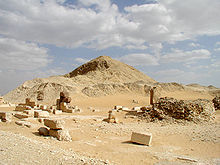
Pepi II Neferkare was a pharaoh of the Sixth Dynasty in Egypt's Old Kingdom who reigned from c. 2278 BC. His second name, Neferkare (Nefer-ka-Re), means "Beautiful is the Ka of Re". He succeeded to the throne at age six, after the death of Merenre I.

Sitre or Tia-Sitre, was the Great Royal Wife of Pharaoh Ramesses I of Egypt and mother of Seti I.

Khentkaus II was a royal woman who lived in ancient Egypt. She was a wife of Egyptian king Neferirkare Kakai of the Fifth Dynasty. She was the mother of two kings, Neferefre and Nyuserre Ini.

Isetnofret was one of the Great Royal Wives of Pharaoh Ramesses II and was the mother of his successor, Merneptah. She was one of the most prominent of the royal wives, along with Nefertari, and was the chief queen after Nefertari's death.

Ahmose-Meritamun was a Queen of Egypt during the early Eighteenth Dynasty. She was both the older sister and the wife of Pharaoh Amenhotep I. She died fairly young and was buried in tomb TT358 in Deir el-Bahari.
Iput I was a queen of ancient Egypt, a daughter of King Unas, the last king of the Fifth Dynasty of Egypt. She married Teti, the first Pharaoh of the Sixth Dynasty of Egypt. Their son was Pepi I Meryre. She possibly ruled as regent for her son Pepi I.

Ankhesenpepi II or Ankhesenmeryre II was a queen consort during the Sixth Dynasty of Egypt. She was the wife of Kings Pepi I and Merenre Nemtyemsaf I, and the mother of Pepi II. She likely served as regent during the minority of her son. She was buried in a pyramid in Saqqara.
Neith was an ancient Egyptian queen consort, one of the principal queens of the Old Kingdom pharaoh Pepi II Neferkare, who ruled. Queen Neith was named after goddess Neith.
Iput was an ancient Egyptian queen consort of the Sixth Dynasty, a sister and wife of Pepi II.
Ankhesenpepi III was an ancient Egyptian queen of the Sixth Dynasty as a consort of Pepi II, who was probably her uncle. She was a daughter of Merenre Nemtyemsaf I and was named after her grandmother, Ankhesenpepi I.
Udjebten or Wedjebten was an ancient Egyptian queen consort, a wife of Pharaoh Pepi II of the Sixth Dynasty.
Nubwenet was an ancient Egyptian queen consort, a wife of Pharaoh Pepi I of the 6th dynasty.
Inenek, also called Inti, was an ancient Egyptian queen consort, a wife of Pharaoh Pepi I of the 6th Dynasty.
Khuit II was a wife of King Teti, the first pharaoh of the Sixth Dynasty of Egypt.
Meritites IV was a queen consort from the Sixth Dynasty. She was believed to be a wife of Pepi I Meryre, but her title of King's Daughter of his body of Pepy-Mennefer (s3t-niswt-nt-kht.f-ppy-mn-nfr) is now understood to indicate that she was a daughter of Pepi I Meryre and wife of a king Neferkare, presumably Pepi II. One more evidence for that theory is that her name means "Beloved of her father".

Isetnofret was a royal woman of Ancient Egypt and, as the Great Royal Wife of Pharaoh Merenptah, she became Isetnofret II.
Tem was an ancient Egyptian queen consort of the 11th Dynasty, a wife of Pharaoh Mentuhotep II and the mother of Mentuhotep III. She was buried in Tomb DBXI.15 in Deir el-Bahari, in her husband's mortuary complex. She outlived her husband and was buried during her son's reign. It is likely that she was of commoner origin, as there is no evidence in her grave that points to a royal origin. She is only named on her sarcophagus and on an offering table. Her titles are "King's beloved wife" (ḥmt-nỉswt mrỉỉ.t=f), King's Mother" (mwt-nỉswt), Mother of the King of Upper and Lower Egypt (mwt-nỉswt-bỉt), and Great of Sceptre (wr.t-ḥt=s).

Henhenet was an ancient Egyptian queen consort, a lower ranking wife of Pharaoh Mentuhotep II of the 11th dynasty. Her tomb (DBXI.11) and small decorated chapel were found in her husband's Deir el-Bahari temple complex, behind the main building, along with the tombs of five other ladies, Ashayet, Kawit, Kemsit, Sadeh and Mayet. Most of them were priestesses of Hathor, so it is possible that they were buried there as part of the goddess's cult, but it is also possible that they were the daughters of nobles the king wanted to keep an eye upon.

Kemsit was an ancient Egyptian queen consort, the wife of pharaoh Mentuhotep II of the 11th Dynasty. Her tomb (TT308) and small decorated chapel were found in her husband's Deir el-Bahari temple complex, behind the main building, along with the tombs of five other ladies, Ashayet, Henhenet, Kawit, Sadeh and Mayet. Most of them were priestesses of Hathor, so it is possible that they were buried there as part of the goddess's cult, but it is also possible that they were the daughters of nobles the king wanted to keep an eye upon.

Sobekemsaf(sbk-m-z3=f) was an ancient Egyptian queen of the 17th Dynasty. She was the wife of pharaoh Nubkheperre Intef and sister of an unidentified pharaoh, probably Sekhemre-Heruhirmaat Intef, Sobekemsaf II or Senakhtenre Ahmose.










